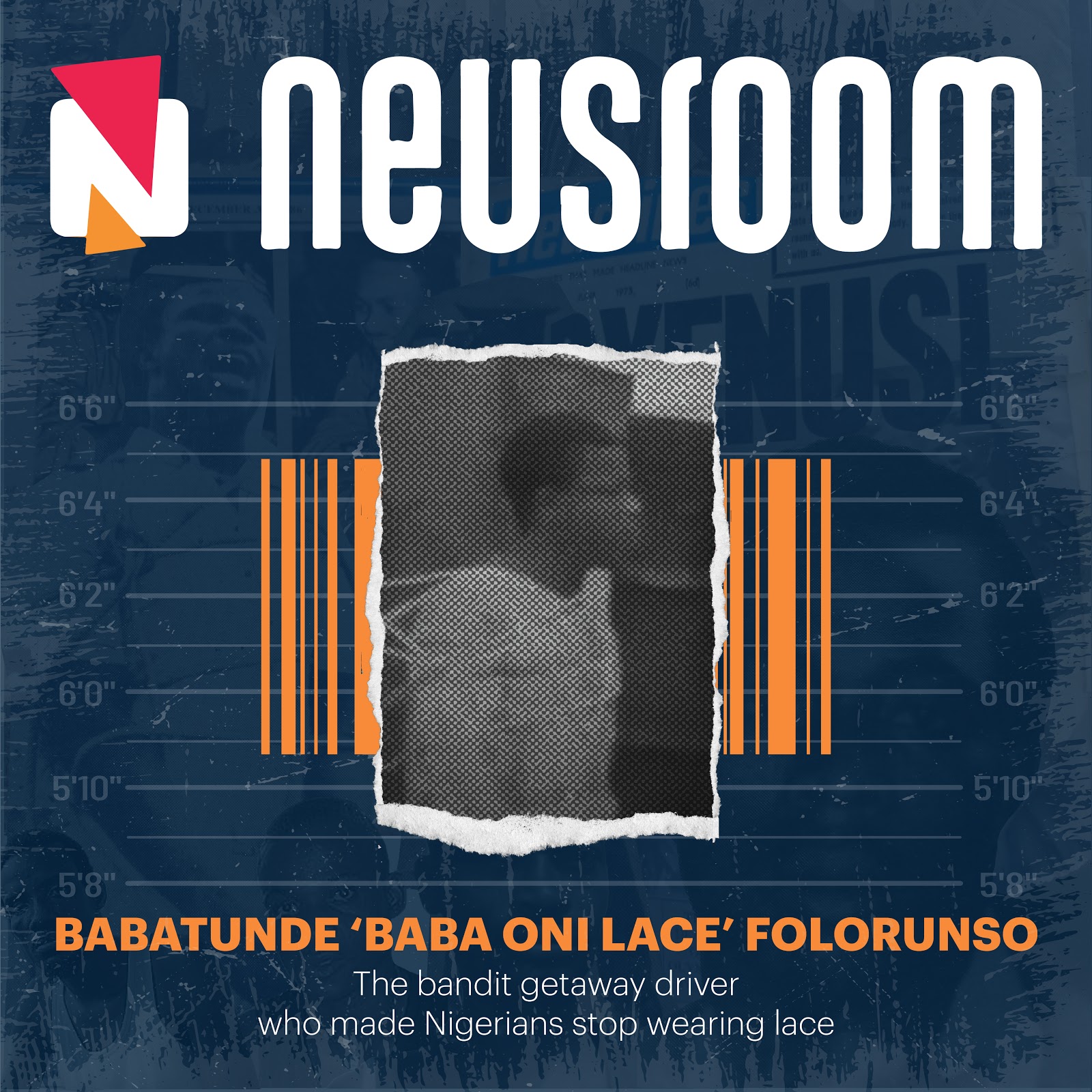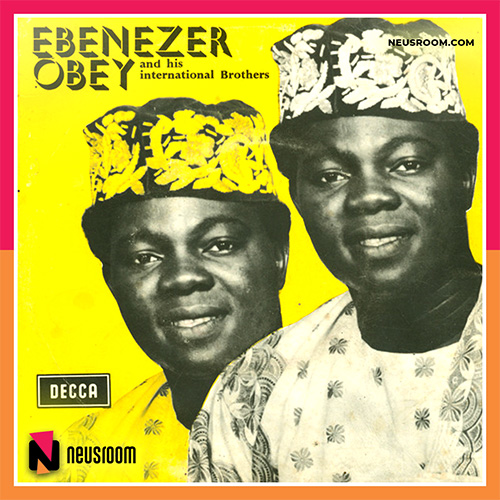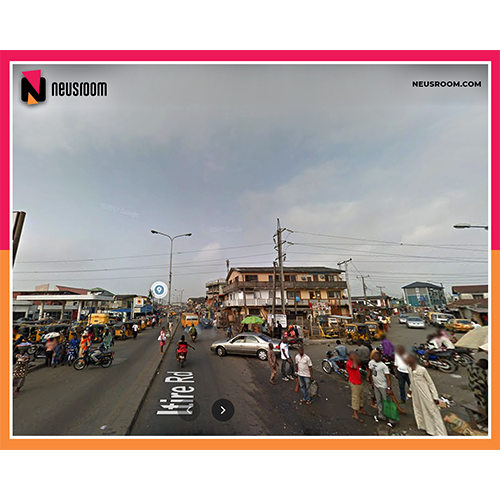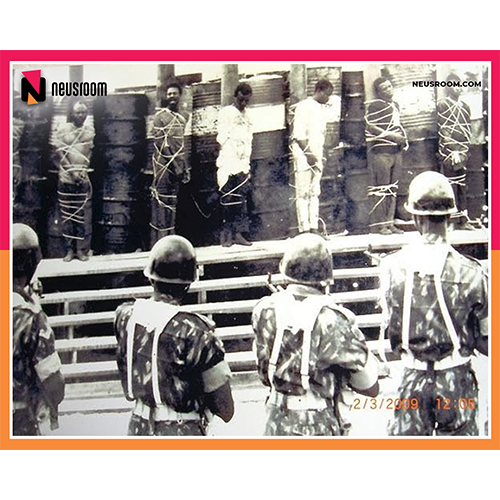Kingpins: The Story of Nigeria’s most Notorious Armed Robbers : Episode 2 – Babatunde ‘Baba Oni Lace’ Folorunso
Babatunde ‘Baba Oni Lace’ Folorunso – the bandit getaway driver who made Nigerians stop wearing lace

Babatunde ‘Baba Oni Lace’ Folorunso – the bandit getaway driver who made Nigerians stop wearing lace.
Written by Michael Orodare for Neusroom
Additional reporting by Folayan Adejoke
11 April 2021
Legendary Nigerian juju musician Ebenezer Obey-Fabiyi is not only famous for using his music for education and entertainment. With his evergreen albums, he addressed social issues that remain relevant today.
One good example: ‘Oro Nipa Lace’, a track off his 1971 album ‘Evergreen Songs Original 20’.
“B’óbinrin bá wọ léèsi, wộn á láya Babátúndé. B’okunrin bá wo léesi, wộn á ní Folorunso.” (If a woman wears clothes made of lace, they call her Babatunde’s wife. If any man wears clothes made of lace, they call him Folorunso).
It was inspired by the craze for ‘Wọnyọsi’ lace, the most expensive fabric in Nigeria in the early 70s; and the execution of Babatunde Folorunso.

Ebenezer Obey-Fabiyi is famous for using his music
for education and entertainment.
Here is the story behind that track and why many lovers of lace in the early 1970s abandoned the luxury material in their wardrobes after Folorunso’s arrest and execution in 1971.
Who was Babatunde Folorunso?
Babatunde Folorunso was the notorious armed robber who wore expensive lace materials to robbery operations. His love for the fabric earned him the moniker ‘Baba Oni Lace’.
He dropped out as an apprentice from a mechanic workshop on Itire road in Surulere, Lagos, with Ishola Oyenusi. The duo abandoned the mechanic workshop for a career in armed robbery, and together they wreaked havoc on Lagos and other parts of the country.
According to newspaper reports seen by Neusroom at the National Archive, the University of Ibadan, Folorunso was also a serial jailbreaker. He was jailed multiple times for armed robbery and he escaped from prison while serving terms. In 1968, while serving 16 years for robbery, he escaped from the Kirikiri prison in Lagos with his partner Ishola Oyenusi.

A recent photo of Itire Road in Surulere, Lagos, where Folorunso and Oyenusi
were mechanic apprentices in the late 1960s. Photo: Google Maps.
Folorunso’s love for lace
In the early 1970s, lace was new in Nigeria, and it was an expensive fabric almost exclusive to the rich. But there was another type of lace that was totally out of the reach of the poor and lower-middle-class. It was called ‘Wọnyọsi’, an imported lace reported to be the most expensive in the 1970s before it was eventually banned by the government.
The rich and those aspiring to climb the social ladder announced their wealth with ‘Wọnyọsi’, a Yoruba coinage meaning ‘sprinkle salt on it’.
This week magazine in its description of Nigerians’ love for lace in the 1970s wrote in a report published in 1971:
“The danfo driver could turn out on a Sunday in a lace material that cost all he could earn in a year, even if he embezzled all the proceeds due to his employer. The Customs department seized and made bonfires of bundles of lace but nothing could dissuade lace-addicts.”
But Folorunso made the job easier for the Customs officers.
Before becoming his own man, he was the get-away driver of Ishola Oyenusi’s armed robbery gang that terrorised Southwest Nigeria in the early 1970s.
As a frontline member of the dreaded Oyenusi gang, Folorunso played crucial roles in all the robbery operations credited to the group, from carjacking to robbing banks and factories.
“The ace getaway car driver was said by the press to be able to drive for more than twenty miles on reverse gear,” Rotimi Ogunjobi wrote in the ‘Somber City’.

A scene at the Lagos bar beach in the 1970s where
convicted armed robbers were executed.
When Folorunso, Oyenusi, and other members of the gang were eventually arrested in 1971. His trial lasted for only two days in April 1971 before he was sentenced to death.
‘Baba Oni Lace’ as he was alternatively called made history on July 24, 1971, as one of the first criminals to be executed behind the stake at the Lagos Bar Beach which became the execution ground for criminals in the 1970s.
Even his imminent death did not deter him from appearing in public (from the prison to the stake) in his beloved lace material. According to the account of Tunde Akingbade in the book “Ilaro: Memories of Operation ‘Wet E’ and Civil War Years,” on the day Folorunso was executed, he wore one of his lace materials to his execution ground.
After his execution, lace became unappealing. People began to imply that anyone who wore the material had links with Babatunde Folorunso or was an armed robber.

A cross section of newsmen at the Lagos Bar beach to witness
the execution of armed robbers. Photo: Nairaland.
Obey made attempts to address the stigma in ‘Oro nipa Lace’:
“Ẹgbe buburu, awon yẹn b’ẹgbẹ rere jẹ.
“Ko si ohun to dara to ka sisẹ, ka t’ẹpa mosẹ… Ẹma f’oju buruku wooni léèsi, ẹni to jale, iyẹn loyẹ ka bawi.” (Bad association has tarnished good association. There’s nothing like being hardworking. Don’t stigmatise anyone who wears lace, whoever is the thief should be admonished).
‘Oro Nipa Lace’ was one of the six tracks from the 52-minute long album that had other tracks like “Eye To Ba Fara Wegun, Ode To Nso Eledumare, Ore Mi Ese Pelepele, Eye To Ma Ba Kowe Ke, Awa Sope Odun.”
In the song, Obey further questioned why people will have luxurious clothes at home and be scared to wear them to events because of stigma.
Nobel laureate Prof Wole Soyinka also wrote about the love for Wonyosi lace in ‘Opera Wonyosi’ (a mindless fool buys himself a wonyosi lace) published in 1981.


One Comment